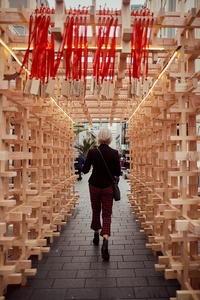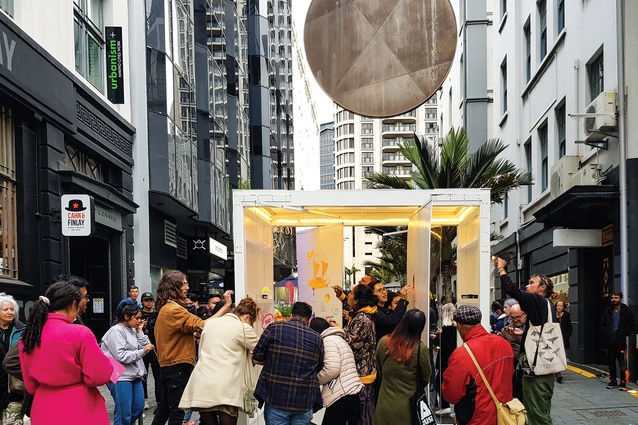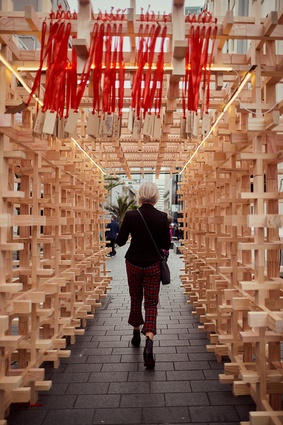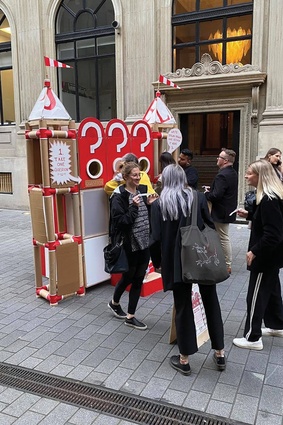Review: Urban Art Village
The theme of connection was the thread throughout the 2020 Urban Art Village. Following Auckland’s two COVID-19 lockdowns, the exhibitors felt it was important to recognise interaction with the public and especially those working back in the CBD.
Funded and supported by Heart of the City as part of Auckland Art Week, Urban Art Village comprised four interactive installations from University of Auckland architecture students and one giveaway-format game show. O’Connell Street was closed and pedestrianised for the event.
This was the fourth iteration for Matt Liggins, teacher at the Auckland architecture school, who began the Urban Art Village in 2018 under Deborah White’s initiative.
Liggins’ four-hour game show was a hybrid of It’s in the Bag, Trivial Pursuit and Wheel of Fortune. The ideas of sustainability and random kindness were combined through winning a present by answering a question via spinning a wheel. Prizes came from charity op shops and were placed in recycled boxes. The nostalgic, Kiwiana items were to be reused to reduce landfill. There was much engagement from the public, who helped answer questions and swapped prizes.

Three of the student installations were parts of final MArch (Prof) theses and one was conceived and built by two third-year undergraduates finishing their BAS degrees.
Rosemary Li’s installation, #hashtag Wish Tree, looked to revive the traditional Chinese ‘dougong’ joinery technique using modern fabrication – mass-producing the complex interlocking joints through technology. The free-standing frame structure does not require a single nail or drop of glue. As part of the experience, people wrote messages on wooden squares, which were attached to red ribbons (signs of good luck and good health). The sea of ribbons on the structure created New Zealand’s October Covid-19 case curve.
Finn Forstner’s installation, The Architect Comes to Town, featured the Architectural Machine and was designed as an observation on how the architectural profession interacts with, and designs for, the public under the guise of community consultation. Specific questions were fed to the participants via the façade, under the allure of chance, and questions were answered by a design. The answers incorporated politics in architecture, use of jargon and individual preference. The outcome was a physical drawing of all the ideas put forward to acknowledge the intangible conversations of the crowd.
Angus Carson’s installation, Grow Your Own Building, explored ‘mycoterials’ – mycelium (fungi) materials – in the construction industry. There has been global interest in manipulating the growth of mycelium to create lightweight, strong, fire-resistant products with thermal and acoustic qualities. On display were truffle-like balls made up of seeds wrapped in dried mycelium mass. Once the balls are planted, the wrapping dissolves in the soil and nourishes the young seedlings. Carson has been experimenting with New Zealand’s oyster mushroom (Pleurotus parsonsiae) and turkey tail mushroom (Trametes versicolor), dehydrating the latter to create acoustic panels. Mycelium could be used in architecture and construction industries to reduce the use of finite materials, carbon emissions and end-of-life waste.

Philip Lee and Jack Wu’s installation, The Box: Reflection and Rumination, incorporated four pivoting walls: two glass panels and two plywood panels on which the public could draw, write and paint. This was a space for reflecting on experiences of living under lockdown through art. Post-installation, the box can be dismantled and reconstructed, where traces of fun and diverse interaction remain visible.
This event offered students real-world experience: a client, planning, marketing, health and safety constraints, permits and demount. This can never be taught in a formal way and, especially after weeks of online teaching thanks to COVID-19, Art Week 2020 resonated with students and the public, demonstrating that connections and interpersonal engagement enrich our lives.













